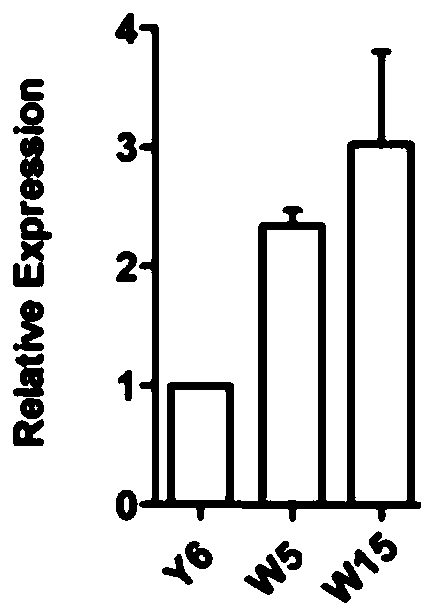BnSPL14 gene and protein, and application thereof in controlling strain types of Brassica napus L.
A technology of Brassica napus and plant type, applied in the fields of application, genetic engineering, plant gene improvement, etc., can solve the problems of increased branch number and long cycle of Brassica napus
- Summary
- Abstract
- Description
- Claims
- Application Information
AI Technical Summary
Problems solved by technology
Method used
Image
Examples
Embodiment 1
[0033] Example 1: qPCR analysis of Brassica napus endogenous BnSPL14 Gene Expression in Brassica napus-White Mustard Introgression Progeny Multi-branched Materials
[0034]With the help of electrofusion technology, somatic cells of Brassica napus "Yangyou 6" (Y6) were fused with white mustard to obtain hybrid offspring, and then the hybrid offspring were continuously backcrossed with the parent Y6 for multiple generations, and the materials obtained by backcrossing were self-crossed The Brassica napus-White mustard introgression material was obtained. After multiple generations of backcrossing, the genetic background of the introgression material was very similar to that of the parent Y6, and the phenotype of the introgression material could be inherited stably. Among them, W5 and Compared with the recurrent parent Y6, the number of branches in W15 material increased significantly. The samples of Y6, W5 and W15 were taken, quickly placed in liquid nitrogen, and the total RNA ...
Embodiment 2
[0035] Embodiment 2: Brassica napus BnSPL14 molecular cloning of genes
[0036] Brassica napus “Darmor-bzh” seedlings at the three-leaf and one-heart stage were taken, quick-frozen in liquid nitrogen, and stored in a -70°C refrigerator for extraction of total RNA. Total RNA was extracted using the RNAiso Plus kit from Dalian TaKaRa Company. Brassica napus cDNA was synthesized in accordance with the instructions of HiScript 1st Strand cDNA Synthesis Kit of Nanjing Novizan Biotechnology Co., Ltd. for first-strand synthesis.
[0037] The first strand of cDNA synthesized by the above kit was used as the amplification template, and the designed SPL14 F: 5'-GGACGGAGACGAACAAGG-3' (SEQ ID NO: 3) and SPL14 R: 5'-GTCGCAGACTCACAGTAAAGC-3' (SEQ ID NO: 4) as primers, use RT-PCR for cDNA amplification, the amplification conditions are: 94°C for 3 min, 94°C for 15 s, 59°C for 15 s, 72°C for 3 min, a total of 35 cycles; 72°C for 10 min. After PCR, electrophoresis analysis was performed, an...
Embodiment 3
[0038] Example 3: BnSPL14 Construction of gene overexpression vector
[0039] for better analysis BnSPL14 The function of the gene, the applicant overexpressed it in Brassica napus, and studied the function of the gene by observing the phenotype of the transgenic plants.
[0040] The method for constructing the overexpression vector is as follows: the above-mentioned sequence-verified BnSPL14 gene cloning vector plasmid BnSPL14 -T as template, use primer SPL14GF: 5'-ggACTAGTccGGACGGAGACGAACAAGG-3' (SEQ ID NO: 5), sequence-specific primer plus linker Speech I site) and SPL14 GR: 5'-aGGCGCGCCtGTCGCAGACTCACAGTAAAGC-3' (SEQ ID NO:6), sequence-specific primer plus linker Asc Site I) cDNA amplification was carried out by RT-PCR. The amplification conditions were: 94°C for 3 min, 94°C for 15 s, 58°C for 15 s, 72°C for 3 min, a total of 35 cycles; 72°C for 10 min. After PCR, electrophoresis analysis was performed, and the target amplified fragment was recovered using the DNA re...
PUM
| Property | Measurement | Unit |
|---|---|---|
| Length | aaaaa | aaaaa |
Abstract
Description
Claims
Application Information
 Login to View More
Login to View More - R&D
- Intellectual Property
- Life Sciences
- Materials
- Tech Scout
- Unparalleled Data Quality
- Higher Quality Content
- 60% Fewer Hallucinations
Browse by: Latest US Patents, China's latest patents, Technical Efficacy Thesaurus, Application Domain, Technology Topic, Popular Technical Reports.
© 2025 PatSnap. All rights reserved.Legal|Privacy policy|Modern Slavery Act Transparency Statement|Sitemap|About US| Contact US: help@patsnap.com



